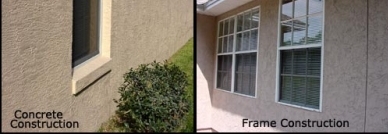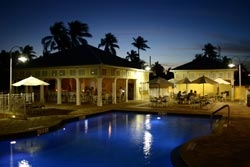|

|
This page will deal with different types of
wall construction. You may want to
check with your homeowners insurance carrier to see if coverage can
be obtained or if there is an additional premium charged for wood
frame construction in a high wind velocity zone.
Masonry
Building
with masonry is a timeless art form that goes back to the great
Egyptian pyramids, Greek temples and Roman cities. Many of those
structures are still standing today! Masonry has always been the
choice for enduring, natural beauty. In modern times, masonry has
been the choice for residences because of the strength and
durability of masonry.
Part of the reason is value offered
to the homebuyer. Another reason is that many builders are turning
to environmentally responsible
(earth-friendly) building methods, and masonry products play a large
role in "green build" or
earth-friendly concepts.
Building with masonry offers a
number of benefits for the homeowner including protection, low
maintenance living, savings and value.
-
-
Wood frame structures are
built with light wood studs and joists. The walls are typically
constructed from 2 x 4 or 2 x 6 studs spaced 16" to 24" apart.
These walls sit on top of the foundation and support upper
floors and the roof. Plaster or gypsum wallboard is attached to
the studs to form the interior finish. The exterior finish may
be wood or metal siding, brick facing, or stucco plaster. New
wood frame houses are required to resist earthquake forces, so
some of the walls are usually constructed with sheets of plywood
nailed to the studs behind the exterior finish.
The typical wood frame roof is constructed with 2 x 6 or 2 x 8
rafters spaced 16" to 24" apart. Roof sheathing (boards in older
structures, plywood in newer buildings) is nailed to the top of
the rafters, and the roofing material (shingles, shakes, tile,
or built-up roofing) is applied to the top of the sheathing. The
floors are usually constructed with 2 x 10 joists spaced
approximately 16" apart. The floor sheathing, similar to roof
sheathing, is nailed to the top of joists (see Figure 1 for an
illustration of a typical wood frame building).
Sometimes a wood frame building may
look like it is made from masonry or concrete. Most commonly
mistaken is the stucco building. Stucco is Portland cement
plaster applied over wire mesh. Nearly all stucco houses are
wood frame structures, although the stucco conceals the wood
framing. Stucco is used as an exterior finish because of its
durability; however, since stucco may not contribute to the
strength of the house, stucco houses are not necessarily
stronger than other wood frame structures. To determine whether
there is a wood frame under the stucco, knock on the wall from
the outside---the wall will sound hollow.
Another example of a disguised wood
frame is the building with veneer. Exterior siding can look like
metal or masonry; for example, there is an asphalt siding that
looks like brick. To determine whether a building is wood frame,
knock on the siding-it will sound hollow. Sometimes, wood frame
buildings have a real masonry veneer which can "peel off" in
earthquakes. If you have such veneer on your house, contact an
architect or civil or structural engineer for a detailed
investigation.
Concrete
Block vs. Wood Frame Construction
Most homes built in Florida
today have a stucco exterior finish. More important is
what lies beneath that stucco finish. Is it wood framing
or concrete block? The photos below illustrate the
easiest way to tell if the construction is frame or
block. With frame construction, the windows will almost
always be flush with the wall. With block construction,
the window will be recessed about four inches and
sometimes will have a precast sill.

Truth is, even most homes
that are said to be block construction have some
wood frame elements. Even a home with all concrete
block exterior walls will have wood roof trusses,
baseboards, and furring strips for the drywall.
While some builders use metal interior studs, the
load bearing walls will be built with wood.
Bottom line, concrete block
construction is more termite resistant, simply
because there is less wood for the termites to eat.
Concrete block construction is also considered to be
more wind resistant, though wood frame can be built
to withstand up to 120 mph winds. Wood frame
construction allows for more insulation in the
walls, which means higher energy efficiency. It also
allows for more detail and angle construction than
concrete block. Stucco over wood frame construction
is less of a concern than it was five years ago,
with the advent of more advanced and effective
termite prevention and treatment systems.
Martin County: (772) 214-9929 Broward/Palm Beach Counties: (954) 340-6615
Email me at:
ev@magnuminspections.com
(Back to Top)
|
 |


